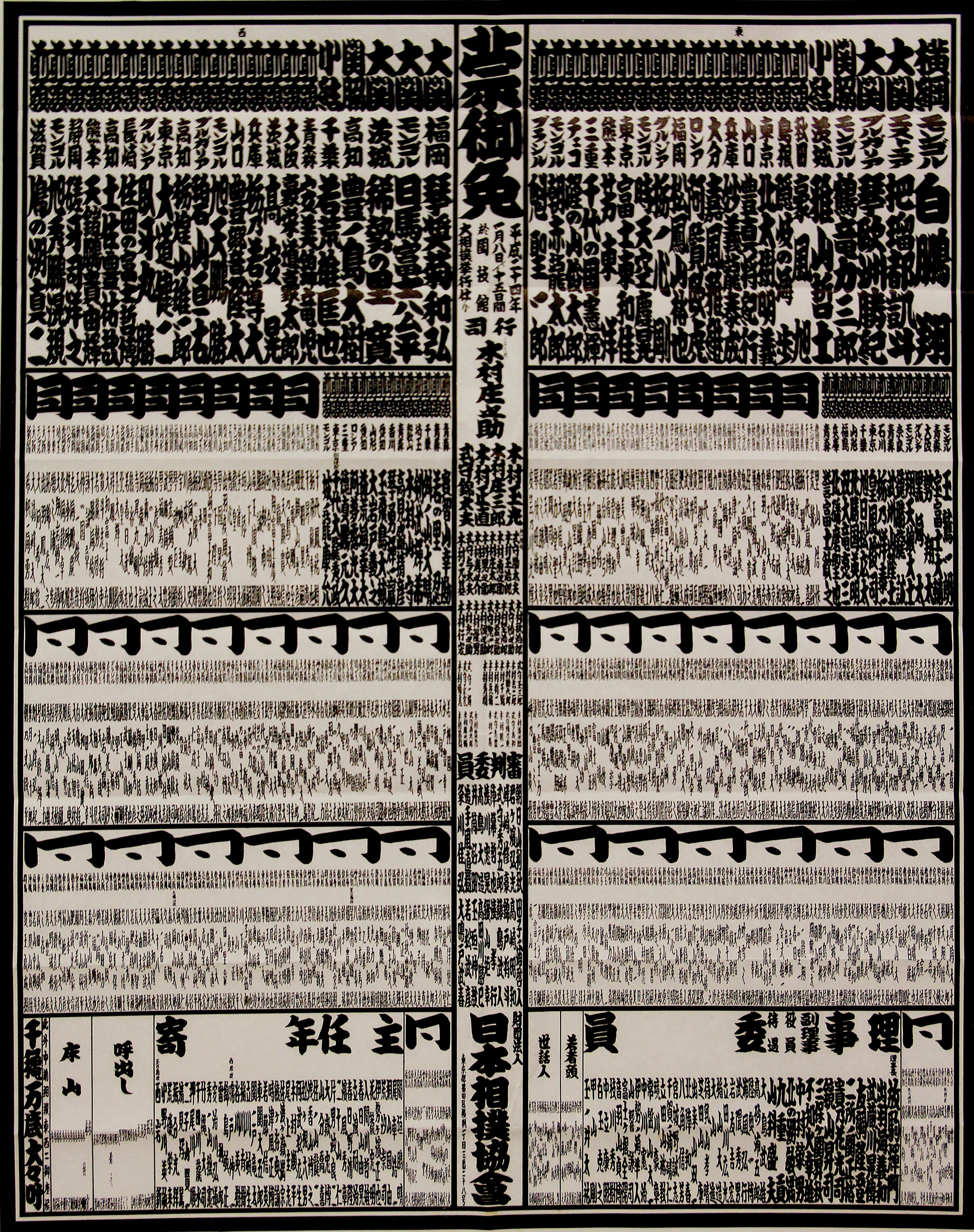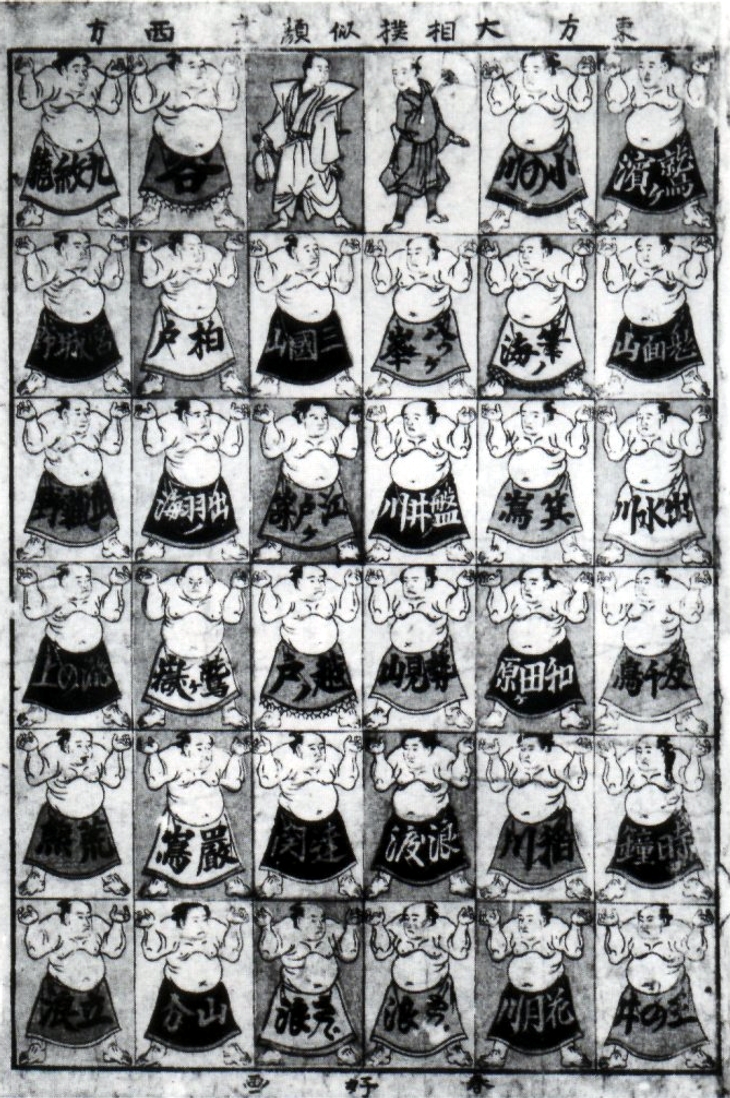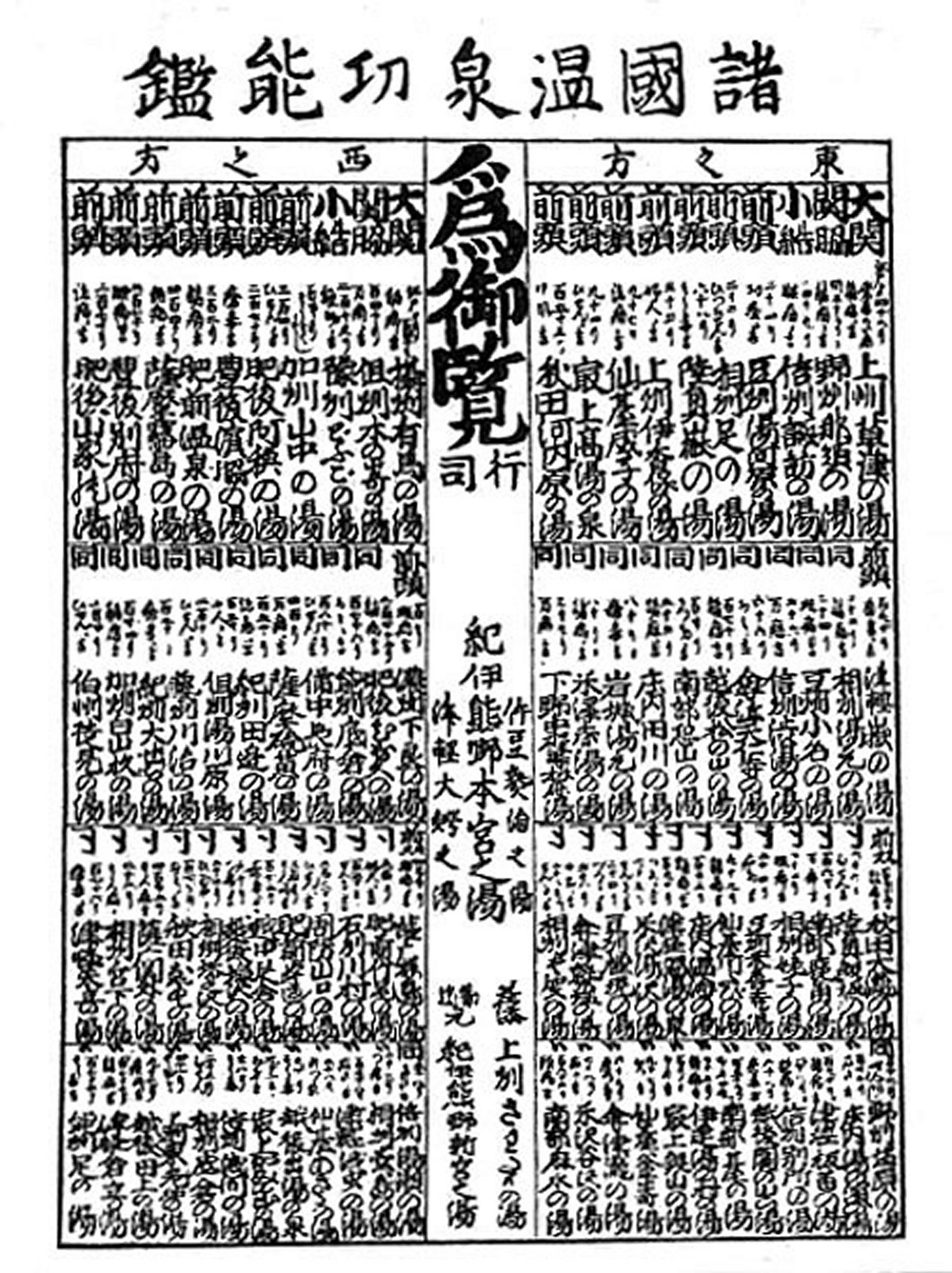Banzuke2.jpg on:
[Wikipedia]
[Google]
[Amazon]
 A , officially called is a document listing the rankings of professional sumo wrestlers published before each official tournament (''
A , officially called is a document listing the rankings of professional sumo wrestlers published before each official tournament (''

 The rankings on the ''banzuke'' are decided by an assembly composed of 20 sumo judges and three supervisors who gather a few days after each official tournament. The assembly assigns ranks to over 600 wrestlers in six divisions based on their performance in the previous tournament. There are no precise rules for assigning rank, but the general rule is that a wrestler who achieved ''
The rankings on the ''banzuke'' are decided by an assembly composed of 20 sumo judges and three supervisors who gather a few days after each official tournament. The assembly assigns ranks to over 600 wrestlers in six divisions based on their performance in the previous tournament. There are no precise rules for assigning rank, but the general rule is that a wrestler who achieved ''
Professional rankings: The Banzuke
{{refend Sumo terminology Sport in Japan
 A , officially called is a document listing the rankings of professional sumo wrestlers published before each official tournament (''
A , officially called is a document listing the rankings of professional sumo wrestlers published before each official tournament (''honbasho
A is an official professional sumo tournament. The number of ''honbasho'' every year has varied along the years; since 1958 there are six tournaments every year. Only ''honbasho'' results matter in determining promotion and relegation for ''riki ...
''). The term can also refer to the rankings themselves. The document is normally released about two weeks before the tournament begins.
On the ''banzuke'', wrestlers are divided into East, which is printed on the right, and West, which is printed on the left. Each wrestler's full ''shikona
A is a sumo wrestler's ring name. The tradition of ring names in sumo dates back to the Edo period, where they were used as a means to attract customers and hide the identities of the '' rikishi''.
Like standard Japanese names, a ''shikona'' ...
'' (ring name), hometown and rank is also listed. The top of the page starts with the highest ranked ''makuuchi
, or , is the top division of the six divisions of professional sumo. Its size is fixed at 42 wrestlers ('' rikishi''), ordered into five ranks according to their ability as defined by their performance in previous tournaments.
This is the o ...
'' wrestlers printed in the largest characters, down to the wrestlers in the lowest divisions which are written in much smaller characters. The names of ''gyōji
A ''gyōji'' () is a referee in professional sumo wrestling in Japan.
''Gyōji'' usually enter the sumo world as teenagers and remain employees of the Sumo Association until they retire aged 65. There are currently a little over 40 active ''gy� ...
'' (sumo referees), ''yobidashi
A is an announcer who calls a professional sumo wrestler, or ''rikishi'', to the ''dohyō'' (wrestling ring) immediately prior to his bout. He does this by calling the name of each wrestler fighting in turn while holding a traditional folding fa ...
'' (ushers/handymen), '' shimpan'' (judges), ''oyakata
The following words are terms used in sumo wrestling in Japan.
A
B
C
D
E
F
G
H
...
'' (elders of the Japan Sumo Association
The is the body that operates and controls professional sumo wrestling (called ''Ōzumō'', 大相撲) in Japan under the jurisdiction of the Japanese Ministry of Education, Culture, Sports, Science and Technology (MEXT). '' Rikishi'' (active ...
), and occasionally ''tokoyama
A is a hairdresser employed by the Japan Sumo Association to cut and prepare sumo wrestlers' hair, which is done in the style. The Sumo Association ranks them according to experience and ability and only the most senior are entitled to prepar ...
'' (hairdressers) are also listed.
While not as old as sumo itself, the form and production of this document can be traced as far back as 1761, and has been a defining component of sumo for centuries. As is the traditional Japanese style, a ''banzuke'' is meant to be read right to left, top to bottom. It is considered a collector's item by sumo fans.
''Banzuke'' preparation

 The rankings on the ''banzuke'' are decided by an assembly composed of 20 sumo judges and three supervisors who gather a few days after each official tournament. The assembly assigns ranks to over 600 wrestlers in six divisions based on their performance in the previous tournament. There are no precise rules for assigning rank, but the general rule is that a wrestler who achieved ''
The rankings on the ''banzuke'' are decided by an assembly composed of 20 sumo judges and three supervisors who gather a few days after each official tournament. The assembly assigns ranks to over 600 wrestlers in six divisions based on their performance in the previous tournament. There are no precise rules for assigning rank, but the general rule is that a wrestler who achieved ''kachi-koshi
The following words are terms used in sumo wrestling in Japan.
A
B
C
D
E
F
G
H
...
'' (a majority of wins) will be raised in the rankings and a wrestler with a ''make-koshi
The following words are terms used in sumo wrestling in Japan.
A
B
C
D
E
F
G
H
...
'' (a majority of losses) will be lowered in the rankings. The degree of a wrestler's success or failure will help give the assembly a benchmark for figuring how far he rises or falls in the rankings.
High-ranking ''gyōji
A ''gyōji'' () is a referee in professional sumo wrestling in Japan.
''Gyōji'' usually enter the sumo world as teenagers and remain employees of the Sumo Association until they retire aged 65. There are currently a little over 40 active ''gy� ...
'' then take on the laborious task of copying down the new rankings on a traditional Japanese paper roll called a ''maki''. They carefully write down the ''kanji
are the logographic Chinese characters taken from the Chinese family of scripts, Chinese script and used in the writing of Japanese language, Japanese. They were made a major part of the Japanese writing system during the time of Old Japanese ...
'' characters of each wrestler participating in a tournament in a calligraphy style called sumo ''moji''. The work is very intricate and requires a great deal of skill. It usually takes about a week to complete the document. The ''banzuke'' information is carefully guarded for several weeks before it is released, which is usually on the Monday 13 days before an official tournament begins. The exception is the information about wrestlers who rise from the third division ''makushita'' to the second division ''juryo'': their names become known immediately because they obtain the status of ''sekitori'' and have to make necessary preparations for it.
The ''banzuke'' is printed at a greatly reduced size on sheets of paper (58 cm x 44 cm) and copies are distributed by the Japan Sumo Association
The is the body that operates and controls professional sumo wrestling (called ''Ōzumō'', 大相撲) in Japan under the jurisdiction of the Japanese Ministry of Education, Culture, Sports, Science and Technology (MEXT). '' Rikishi'' (active ...
. Sumo stables
A stable is a building in which livestock, especially horses, are kept. It most commonly means a building that is divided into separate stalls for individual animals and livestock. There are many different types of stables in use today; the ...
buy a large quantity of them to give to their sponsors. Tea houses in the Tokyo
Tokyo (; ja, 東京, , ), officially the Tokyo Metropolis ( ja, 東京都, label=none, ), is the capital and List of cities in Japan, largest city of Japan. Formerly known as Edo, its metropolitan area () is the most populous in the world, ...
sumo venue Kokugikan also buy them to give out to their patrons. They are also available for purchase for a small fee at tournament sites.
See also
*Glossary of sumo terms
The following words are terms used in sumo wrestling in Japan.
A
B
C
D
E
F
G
H
...
*List of active sumo wrestlers
The following is an alphabetical list of all active professional sumo wrestlers in the top ''makuuchi'' division, and all those currently in lower divisions who have a Wikipedia article. Please refer to professional sumo divisions for more informa ...
References
Professional rankings: The Banzuke
{{refend Sumo terminology Sport in Japan